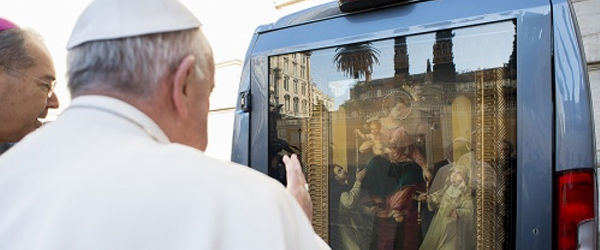A twenty-first century classroom is sometimes not a classroom at all, especially when the topics being studied are current — even controversial — issues that are alive in one’s own home and neighborhood. Learning, along with obtaining the critical thinking skills that are indispensable in life, is best accomplished by immersion. The world — and all of its messy issues — becomes the classroom.As part of its social justice studies and community outreach, St. Bonaventure High School’s Drama Team last weekend presented two one-act plays focused on timely issues. The performances — followed by a dialogue about those issues among attendees and members of community organizations — will be repeated in Ventura and Santa Barbara in coming weeks.“Waiting for Lefty” and “A Line in the Sand: Stories from the US/Mexican Border” pair together to set a foundation for examining the multi-faceted issue of immigration reform, and to encourage people to think through and dialogue about solutions. “Our approach to teaching is to have students engage as much as possible in the topics covered,” explains Deacon Don Huntley, chair of St. Bonaventure’s theology department, and a social justice instructor. “The idea was to do a justice-oriented play. Interactive experiences and follow-up activities are part of the curriculum.”“A Line in the Sand” came to the school’s attention last spring. The play is being supported and promoted by Clergy and Laity United for Economic Justice (CLUE), Citizens for Peaceful Resolutions (CPR), and their members along with migrants and agricultural industry representatives assist with the dialogue that follows each presentation. The Ray Bradbury Theatre and Film Foundation also supports the production.“These plays explore the issues from many angles,” says Patti Strickland, drama department chair and director of the presentations at St. Bonaventure. “‘Waiting for Lefty’ (a 1935 play about labor issues) illustrates how, in coming together, people can find a voice to be heard. This play will segue into ‘A Line in the Sand’ which tells the personal stories and experiences of people directly affected by migration at the U.S./Mexico border.”In some cases, the personal experiences of the actors mirror those of some of the characters they portray.“My dad was an illegal immigrant when I was very young,” says Araceli González, a senior, and female lead in the play. “We talked about that fact in our family — it was present in our lives every day. By doing this play I get to see ‘the other side’ — the sides of farmers, border patrol and residents — and it is eye-opening.”Cast members agree that seeing and hearing all sides of the issues is the first step in solving the problems that arise from the issues. Standing — and walking — in the shoes of others who experience the situation from a different perspective, yet share the same qualities of compassion and concern for human dignity, can open doors and begin communication to find solutions.The way “A Line in the Sand” was written encourages that dialogue.“There are no biases in the play,” senior Joseph Poole stresses. “It just shows you the story and lets you make up your own mind.”Those stories go deeper than what is covered in a one-act play. St. Bonaventure students also have immersion experiences in social justice classes, such as field trips to the strawberry fields to see first-hand what field workers do and how they do it. They share lunch and talk to the field workers about their lives, then return to the classroom to discuss the experience. Immigration lawyers and others in the community have visited classes to discuss the complex issues connected to immigration. The immersion experiences have a powerful effect on the students, who now see real people harvesting food for the general population.“Most people don’t recognize the people in the fields or see the things they are going through,” says senior Conor Boales. “This is about giving a voice to the voiceless. You don’t hear about their hard work, but they are there.”Deacon Huntley says the approach taken by the high school to get the students out into the community to learn, and also do Christian service, has made a big difference in their growth and in their desire to do more. He and Strickland see solutions to society’s issues coming from this generation, who already see things differently in a world where the global lines are blurred. Helping students become aware of the needs is only the first step.“As teachers we facilitate the process for the students to take leadership and do the work,” Huntley says. “We need to get involved. Living our faith becomes the leaven that changes things.”“Waiting for Lefty” and “A Line in the Sand” will be presented Oct. 7 at the Foster Library in Ventura; on Oct. 14 at a location to be determined; and in January (date to be determined) at Ventura City Hall. “A Line in the Sand” also will be presented Oct. 13 at the Santa Barbara Region Congress at Bishop Garcia Diego High School, Santa Barbara, during the lunch hour (1-2 p.m.).{gallery width=100 height=100}gallery/2012/0921/sbplay/{/gallery}

